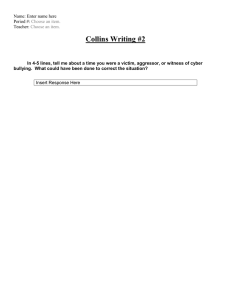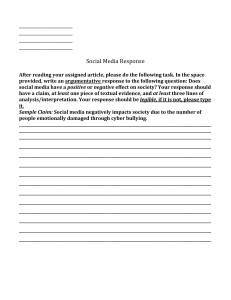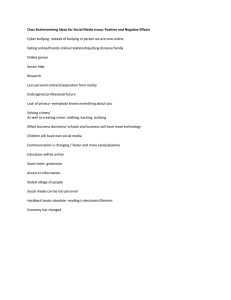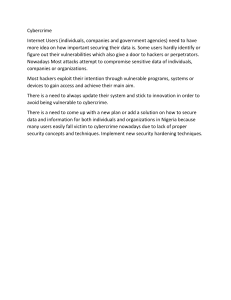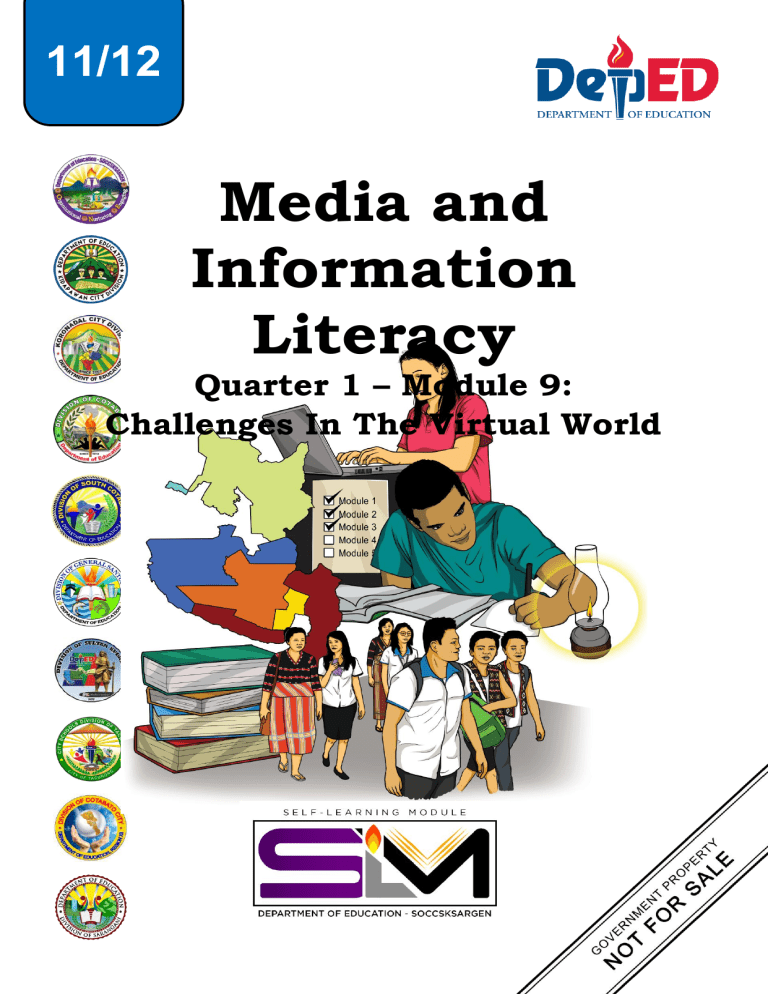
11/12 Media and Information Literacy Quarter 1 – Module 9: Challenges In The Virtual World Media and Information Literacy – Grade 11/12 Self-Learning Module (SLM) Quarter 1 – Module 9: Challenges In The Virtual World First Edition, 2020 Republic Act 8293, section 176 states that: No copyright shall subsist in any work of the Government of the Philippines. However, prior approval of the government agency or office wherein the work is created shall be necessary for exploitation of such work for profit. Such agency or office may, among other things, impose as a condition the payment of royalties. Borrowed materials (i.e., songs, stories, poems, pictures, photos, brand names, trademarks, etc.) included in this module are owned by their respective copyright holders. Every effort has been exerted to locate and seek permission to use these materials from their respective copyright owners. The publisher and authors do not represent nor claim ownership over them. Development Team of the Module Writer: Jenelyn A. Abico Editors: Kenneth B. Cagape, Mary Franciss Antoinette T. Ontal Reviewers: Evelyn C. Frusa PhD, Rolex H, Lotilla, Arvin M. Tejada Illustrator: Layout Artist: John Lester Escalera, Karl Edward B. Panceles Cover Art Designer: Reggie D. Galindez Management Team: Allan G. Farnazo, CESO IV – Regional Director Fiel Y. Almendra, CESO V – Assistant Regional Director Crispin A. Soliven Jr., CESE - Schools Division Superintendent Roberto J. Montero EdD, CESE - ASDS Gilbert B. Barrera – Chief, CLMD Arturo D. Tingson Jr. – REPS, LRMS Peter Van C. Ang-ug – REPS, ADM Gilda A. Orendain - REPS – Subject Area Supervisor Belen Fajemolin PhD - CID Chief Evelyn C. Frusa PhD - Division EPS In Charge of LRMS/ Subject Area Supervisor- ICT Bernardita M. Villano - Division ADM Coordinator Carlo S. Melendres, PhD - EPS – Senior High School Coordinator Subject Area Supervisor- ICT Printed in the Philippines by Department of Education – SOCCSKSARGEN Region Office Address: Telefax: E-mail Address: Regional Center, Brgy. Carpenter Hill, City of Koronadal (083) 2288825/ (083) 2281893 region12@deped.gov.ph 11/12 Media and Information Literacy Quarter 1 – Module 9: Challenges in the Virtual World i Introductory Message For the facilitator: Welcome to the Media and Information Literacy with Grade 11/12 Self-Learning Module (SLM) on Challenges In The Virtual World! This module was collaboratively designed, developed and reviewed by educators both from public and private institutions to assist you, the teacher or facilitator in helping the learners meet the standards set by the K to 12 Curriculum while overcoming their personal, social, and economic constraints in schooling. This learning resource hopes to engage the learners into guided and independent learning activities at their own pace and time. Furthermore, this also aims to help learners acquire the needed 21st century skills while taking into consideration their needs and circumstances. In addition to the material in the main text, you will also see this box in the body of the module: Notes to the Teacher This contains helpful tips or strategies that will help you in guiding the learners. As a facilitator you are expected to orient the learners on how to use this module. You also need to keep track of the learners' progress while allowing them to manage their own learning. Furthermore, you are expected to encourage and assist the learners as they do the tasks included in the module. ii For the learner: Welcome to the Media and Information Literacy - Grade 11/12 Self-Learning Module (SLM) on Challenges In The Virtual World! The hand is one of the most symbolized part of the human body. It is often used to depict skill, action and purpose. Through our hands we may learn, create and accomplish. Hence, the hand in this learning resource signifies that you as a learner is capable and empowered to successfully achieve the relevant competencies and skills at your own pace and time. Your academic success lies in your own hands! This module was designed to provide you with fun and meaningful opportunities for guided and independent learning at your own pace and time. You will be enabled to process the contents of the learning resource while being an active learner. This module has the following parts and corresponding icons: What I Need to Know This will give you an idea of the skills or competencies you are expected to learn in the module. What I Know This part includes an activity that aims to check what you already know about the lesson to take. If you get all the answers correct (100%), you may decide to skip this module. What’s In This is a brief drill or review to help you link the current lesson with the previous one. What’s New In this portion, the new lesson will be introduced to you in various ways such as a story, a song, a poem, a problem opener, an activity or a situation. What is It This section provides a brief discussion of the lesson. This aims to help you discover and understand new concepts and skills. What’s More This comprises activities for independent practice to solidify your understanding and skills of the topic. You may check the answers to the exercises using the Answer Key at the end of the module. What I Have Learned This includes questions or blank sentence/paragraph to be filled in to process what you learned from the lesson. What I Can Do This section provides an activity which will help you transfer your new knowledge or skill into real life situations or concerns. iii Assessment This is a task which aims to evaluate your level of mastery in achieving the learning competency. Additional Activities In this portion, another activity will be given to you to enrich your knowledge or skill of the lesson learned. This also tends retention of learned concepts. Answer Key This contains answers to all activities in the module. At the end of this module you will also find: References This is a list of all sources used in developing this module. The following are some reminders in using this module: 1. Use the module with care. Do not put unnecessary mark/s on any part of the module. Use a separate sheet of paper in answering the exercises. 2. Don’t forget to answer What I Know before moving on to the other activities included in the module. 3. Read the instruction carefully before doing each task. 4. Observe honesty and integrity in doing the tasks and checking your answers. 5. Finish the task at hand before proceeding to the next. 6. Return this module to your teacher/facilitator once you are through with it. If you encounter any difficulty in answering the tasks in this module, do not hesitate to consult your teacher or facilitator. Always bear in mind that you are not alone. We hope that through this material, you will experience meaningful learning and gain deep understanding of the relevant competencies. You can do it! iv What I Need to Know This module was designed and written with you in mind. It is here to help you master the Challenges in The Virtual World. The scope of this module permits it to be used in many different learning situations. The language used recognizes the diverse vocabulary level of students. The lessons are arranged to follow the standard sequence of the course. But the order in which you read them can be changed to correspond with the textbook you are now using. The module is divided into two learning outcomes, namely: LO 1 - explain actions to promote ethical use of media and information (MIL11/12LESI-IIIg22); LO 2 Create a campaign add to combat digital divide, addiction, and bullying. (MIL12/LESI-IIIG-23) After going through this module, you are expected to: a) Describe the challenges/risks of Internet use and where they are most likely to occur; and b) Understand the interdependencies between users’ behaviour and the likelihood of them being a victim or a perpetrator. 1 Definition of Terms Computer Addiction The excessive use of computers to the extent that it interferes with daily life. This excessive use may for example interfere with work or sleep, result in problems with social interaction, or affect mood, relationships, and thought processes. Computer Program Refers to a set of instructions executed by the computer to achieve intended results. Computer System Refers to any device or group of interconnected or related devices, one or more of which, pursuant to a program, performs automated processing of data. It covers any type of device with data processing capabilities including, but not limited to, computers and mobile phones. The device consisting of hardware and software may include input, output, and storage components the may stand alone or be connected in a network or other similar devices. It also includes computer data storage devices or media. Critical Infrastructure Refers to the computer systems, and/or networks, whether physical or virtual, and/or the computer programs, computer data and/or traffic data so vital to this country that the incapacity or destruction of or interference with such system and assets would have a debilitating impact on security, national or economic security, national public health and safety, or any combination of those matters. Cyber Refers to a computer or computer network, the electronic medium in which communication takes place. Cyber Bullying Bullying that takes place online, or using electronic technology such as cell phones, computers, and tablets over communication tools including social media sites, text messages, chat, and websites. Cybersecurity Refers to the collection of tools, policies, risk management approaches, actions, training, best practices, assurance and technologies that can be used to protect the cyber environment and organization and user’s assets. 2 Database Refers to a representation of information, knowledge, facts, concepts, or instructions which are being prepared, processed or stored or have been prepared, processed or stored in a formalized manner and which are intended for use in a computer system. Digital Divide An economic inequality between groups in terms of access to, use of, or knowledge of ICT. The divide within countries (such as the digital divide in the United States) can refer to inequalities between individuals, households, businesses, and geographic areas at different socioeconomic (and other demographic) levels. Interception Refers to listening to, recording, monitoring or surveillance of the content of communications, including procuring of the content of data, either directly, through access and use of a computer system or indirectly, through the use of electronic eavesdropping or tapping devices, at the same time that the communication is occurring. Service Provider Any public or private entity that provides to users of its service the ability to communicate by means of a computer system; and any other entity that processes or stores computer data on behalf of such communication service or users of such service. Subscriber’s Information Refers to any information contained in the form of computer data or any other form that is held by a service provider, relating to subscribers of its services other than traffic or content data and by which identity can be established. Traffic Data or Non-content Data Refers to any computer data other than the content of the communication including, but not limited to, the communication’s origin, destination, route, time, date, size, duration, or type of underlying service. Definition is taken from Fifteenth Congress Second Regular Session, 2012 3 What I Know I. Read each statement carefully, write True if the statement is correct and False if not. Write your answer in your notebook. __________1. RA 10175 is the law that gives protection against cyberbullying. __________2. The golden rule “Do unto others as you would have others do unto you” adheres to the ten rules of cyberbullying. __________3. Excessive use of technology that interferes activities in daily life refers to cybercrime. __________4. Protecting oneself while online is everyone’s responsibility. __________5. Identity theft refers to harvesting of personal details to ransack other’s bank accounts. II. Matching Type. Match each concept in column A with those of column B. Column A Column B ____6. Economic inequality between groups in terms of access to, use of, or knowledge of ICT. ____7. Sending messages/emails of insult, humiliating photos and fake profiles deliberately shared across social media. ____8. Happens when sellers pretend to sell goods or services which, after payment, either do not show the promised attributes or are not delivered at all. ____9. Harvesting bank details, in particular personal identification numbers with the intent to ransack other people’s bank accounts. ____10. A governing act that aims to address legal issues concerning online interactions and technology related concerns in the country. 4 A. Phishing B. RA 10175 C. RA 8293 D. Digital divide E. Commercial fraud F. Cyberbullying Lesson 9 Challenges in The Virtual World Media and other information providers play a central role in information and communication processes. Nowadays, media become the common outlet of selfexpression and creativity. Its huge influence spreads speedily across the globe. The connection between technological advances and people’s connectivity created a huge impact on the lives of today’s generation. This module covers all the abovementioned concepts. What’s In Intellectual Property is the product of one’s mind. There are five (5) types of intellectual property namely: copyright, patent, trademark, industrial design and geographical origin. All types of intellectual property are covered and protected by law. Violation of the use of it is punishable by law. Aside from the violation of Intellectual Property, numerous unethical actions arise in media. These include cybercrimes such as cyberbullying, computer addiction, identity theft, etc. To learn more about the topic, let’s take a look at the activity. Notes to the Teacher You may provide news articles that reports how cybercrime increased due to the internet. 5 What’s New Activity 1 Construct your own definition for the following concepts 1. Cybercrime __________________________________________________________________________________ __________________________________________________________________________________ __________________________________________________________________________________ 2. Computer addiction __________________________________________________________________________________ __________________________________________________________________________________ __________________________________________________________________________________ 3. Cyber bullying __________________________________________________________________________________ __________________________________________________________________________________ __________________________________________________________________________________ 6 What is It CHALLENGES AND RISKS IN MEDIA People nowadays find media as the fastest means of exchanging numerous information, but lack to note the possible harmful effects of it. The International Human Rights Law manages to provide security against possible harmful online content. The following are risks related to online contact: Money theft/phishing refers to the process of harvesting bank details, in particular, personal identification numbers (PINs) and transaction authentication numbers (TANs), with the intent to ransack other people’s bank accounts. Commercial fraud: Commercial fraud happens when sellers pretend to sell goods or services which, after payment, either do not show the promised attributes or are not delivered at all. Grooming: Grooming refers to pedophiles using the Internet as a means to contact children and young people while concealing their adult identity. Bullying: Various types of bullying seem always to be part of people’s lives. Even though publishing content like defamatory pictures can be part of bullying, the phenomenon is chiefly related to online contact. Multifunctional mobile phones are often used for taking pictures with the intention of bullying and then uploading the pictures to the Internet or sending them via multimedia messaging (MMS) to others. Another example is sending messages/emails of insult, humiliating photos and fake profiles deliberately shared across social media. Computer addiction: the excessive use of computers to the extent that it interferes with daily life. Another issue in media use is the so-called Digital divide- the economic inequality between groups in terms of access to, use of, or knowledge of ICT. To address the above-mentioned media-related issues, the Philippine Government approved the Republic Act 10175 also known as the “Cybercrime Prevention Act of 2012” which aims to address legal issues concerning online interactions and technology related concerns in the country. RA 10175 of 2012, includes the following. 7 CHAPTER II. PUNISHABLE ACTS Section 4. Cybercrime Offenses. — The following acts constitute the offense of cybercrime punishable under this Act: (a) Offenses against the confidentiality, integrity, and availability of computer data and systems: (1) Illegal Access – The access to the whole or any part of a computer system without right. (2) Illegal Interception – The interception made by technical means without right of any non-public transmission of computer data to, from, or within a computer system including electromagnetic emissions from a computer system carrying such computer data. (3) Data Interference — The intentional or reckless alteration, damaging, deletion or deterioration of computer data, electronic document, or electronic data message, without right, including the introduction or transmission of viruses. (4) System Interference — The intentional alteration or reckless hindering or interference with the functioning of a computer or computer network by inputting, transmitting, damaging, deleting, deteriorating, altering or suppressing computer data or program, electronic document, or electronic data message, without right or authority, including the introduction or transmission of viruses. (5) Misuse of Devices (i) The use, production, sale, procurement, importation, distribution, or otherwise making available, without right, of: (6) Cyber-squatting – The acquisition of a domain name over the internet in bad faith to profit, mislead, destroy reputation, and deprive others from registering the same. (b) Computer-related Offenses: (1) Computer-related Forgery (i) The input, alteration, or deletion of any computer data without right resulting in inauthentic data with the intent that it be considered or acted upon for legal purposes as if it were authentic, regardless whether or not the data is directly readable and intelligible; or (2) Computer-related Fraud — The unauthorized input, alteration, or deletion of computer data or program or interference in the functioning of a computer system, causing damage thereby with fraudulent intent: Provided, That if no 8 damage has yet been caused, the penalty imposable shall be one (1) degree lower. (3) Computer-related Identity Theft – The intentional acquisition, use, misuse, transfer, possession, alteration or deletion of identifying information belonging to another, whether natural or juridical, without right: Provided, That if no damage has yet been caused, the penalty imposable shall be one (1) degree lower. (c) Content-related Offenses: (1) Cybersex — The willful engagement, maintenance, control, or operation, directly or indirectly, of any lascivious exhibition of sexual organs or sexual activity, with the aid of a computer system, for favor or consideration. (2) Child Pornography — The unlawful or prohibited acts defined and punishable by Republic Act No. 9775 or the Anti-Child Pornography Act of 2009, committed through a computer system: Provided, That the penalty to be imposed shall be (1) one degree higher than that provided for in Republic Act No. 9775. (3) Unsolicited Commercial Communications. — The transmission of commercial electronic communication with the use of computer system which seek to advertise, sell, or offer for sale products and services are prohibited unless: (i) There is prior affirmative consent from the recipient; or (ii) The primary intent of the communication is for service and/or administrative announcements from the sender to its existing users, subscribers or customers; or (4) Libel — The unlawful or prohibited acts of libel as defined in Article 355 of the Revised Penal Code, as amended, committed through a computer system or any other similar means which may be devised in the future. Furthermore, Section 8 of the law tackles about Penalties such as — Any person found guilty of any of the punishable acts enumerated in Sections 4(a) and 4(b) of this Act shall be punished with imprisonment of prision mayor or a fine of at least Two hundred thousand pesos (PhP200,000.00) up to a maximum amount commensurate to the damage incurred or both. Any person found guilty of the punishable act under Section 4(a)(5) shall be punished with imprisonment of prision mayor or a fine of not more than Five hundred thousand pesos (PhP500,000.00) or both. With the never-ending risks in media, protecting oneself is everyone’s responsibility. 9 safebook Image source: https://safeinwarwickshire.com/2014/08/28/safebook-a-few-simple-tips-whenusing-socialmedia-how-to-avoid-cyberbullying-including-advice-toparents/amp/ The image above suggests ways everyone should consider every time in contact with the virtual world. 10 . What’s More Activity: Read and discuss each question below. Write your answer in your notebook. Guide Questions: 1. Discuss how cybercrime becomes a national concern. __________________________________________________________________________________ __________________________________________________________________________________ __________________________________________________________________________________ 2. What makes computer addiction a problem? __________________________________________________________________________________ __________________________________________________________________________________ __________________________________________________________________________________ 3. Explain how somebody can be a victim of cyber bullying? __________________________________________________________________________________ __________________________________________________________________________________ __________________________________________________________________________________ 11 What I Have Learned Let’s summarize our lesson by answering the following questions. Do it in your activity notebook. 1. What is cybercrime? __________________________________________________________________________________ __________________________________________________________________________________ 2. Enumerate examples of cybercrime __________________________________________________________________________________ __________________________________________________________________________________ 3. We can combat cybercrime by… __________________________________________________________________________________ __________________________________________________________________________________ 4. We can protect ourselves from cybercrime by… __________________________________________________________________________________ __________________________________________________________________________________ 12 What I Can Do As a student, how can you help combat cyberbullying? Present your answer through an infographic. Do it in your activity notebook. Sample Infographic: Source: https://graphicspedia.net/facts-and-solutions-for-cyber-bullying-infographic/ 13 Infographics Sample Rubric Criteria 5 Content is accurate and all required information is presented in a logical order. 4 Content is accurate but Some required information is missing and/or not presented in a logical order, but is still generally easy to follow 3 Content is accurate but some required information is missing and/or not presented in a logical order, making it difficult to follow. 2 Content is questionable Information is not presented in a logical order, making it difficult to follow Presentation flows well and logically. Presentation reflects extensive use of tools in a creative way. Presentation flows well. Tools are used correctly. Presentation flows well. Some tools are used to show acceptable understanding Presentation is unorganize. Tools are not used in a relevant manner. Use of visual design elements are appropriate. Layout is pleasing to the eye. Visual design elements are appropriate. Layout is cluttered. Most visual design elements are appropriate. Visual design elements are inappropriat e or layout is messy. Use of Visual Use of visual Design design Principles principles are used appropriately. A visual design principle is violated. Two visual design principles are violated. Many visual design principles were used inappropriat ely. No spelling or Few spelling grammatical errors. Few errors. grammar errors. Some spelling and grammatical errors. Many spelling and grammatical errors are found. Content Presentation of Information Use of Visual Design Elements (point, line, shape, value, texture, and color) Mechanics Rubric adapted from Teacher Plane tvia http://teacherplanet.com 14 15 Assessment Activity 1: Solve Me! Instruction: Give the possible effects of the given online acts as well as solution to address them. Answer it in your activity notebook. PROBLEM EFFECT • Digital Divide •BULLYING •Computer Addiction 16 SOLUTION Additional Activities Create a short rap that suggest ways on how stop cyber bullying. __________________________________________________________________________________ __________________________________________________________________________________ __________________________________________________________________________________ __________________________________________________________________________________ __________________________________________________________________________________ __________________________________________________________________________________ __________________________________________________________________________________ __________________________________________________________________________________ __________________________________________________________________________________ __________________________________________________________________________________ __________________________________________________________________________________ __________________________________________________________________________________ 17 18 What I Know 1. TRUE 2. FALSE 3. FALSE 4. TRUE 5. FALSE 6. D 7. F 8. E 9. A 10. B Answer Key References Commission on higher Education, 2016. Teaching Guide for Senior High School MEDIA AND INFORMATION LITERACY CORE SUBJECT. Media and Information Literacy Curriculum Guide by DepEd http://unesco.mil-for-teachers.unaoc.org/modules/module-7/unit-2/ http://www.lawphil.net/statutes/repacts/ra2012/ra_10175_2012.html 19 DISCLAIMER This Self-learning Module (SLM) was developed by DepEd SOCCSKSARGEN with the primary objective of preparing for and addressing the new normal. Contents of this module were based on DepEd’s Most Essential Learning Competencies (MELC). This is a supplementary material to be used by all learners of Region XII in all public schools beginning SY 2020-2021. The process of LR development was observed in the production of this module. This is version 1.0. We highly encourage feedback, comments, and recommendations. For inquiries or feedback, please write or call: Department of Education – SOCCSKSARGEN Learning Resource Management System (LRMS) Regional Center, Brgy. Carpenter Hill, City of Koronadal Telefax No.: (083) 2288825/ (083) 2281893 Email Address: region12@deped.gov.ph 20

